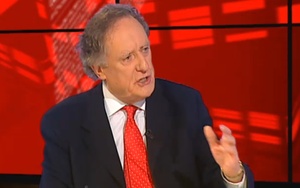Another Ulster Bank fiasco as apologies are made to 'out-of-pocket customers' for latest systems fault
Some customer accounts hit by the latest Ulster Bank ATM machine fault of duplicating debits.
The number of cash-dispensing ATMs affected by the latest fault has not been confirmed.
Ulster Bank has apologised to customers in Northern Ireland following the latest problem which saw some customers being debited twice for a single transaction.
The bank, which suffered a significant IT problem in 2012, said it was working to correct the problem and restore funds to customers’ accounts by tonight. However, the bank has not yet given any indication how many accounts were compromised by the technical problem.
The number of cash-dispensing ATMs affected by the fault has not been confirmed.
A spokesman said: “We are aware of some issues with duplicated debits, we are working hard to fix this, sorry for any inconvenience.”
The bank stressed yesterday that customers would not be left “out of pocket”.
“We are aware of an issue regarding duplicate ATM transactions involving some Ulster Bank customers between 4.15pm on Easter Monday and 4.15pm on Tuesday afternoon.
“We are working to correct this for affected customers and restore money to accounts tonight.
“Customers will not be left out of pocket and can contact us if they require further assistance. We apologise for any inconvenience caused.”
Massive systems failure
The bank had to apologise for problems last December when some services were interrupted.
This followed a massive systems failure in 2012 when large numbers of customers lost access to their accounts.
Some 100,000 customer were affected by the fault which resulted in 80 branches staying open late to deal with the backlog of transactions.
Ulster Bank said the original technical problem was caused by a software upgrade to the payment processing system which was corrupted.
Very low approval rate for mortgage-to-rent scheme approvals by our Banks in Ireland


JUST 38 PROPERTIES HAVE TRANSFERRED OWNERSHIP UNDER THE MORTGAGE-TO-RENT SCHEME
A scheme to allow people with unsustainable mortgages give up ownership of their homes and rent them instead has seen less than 2% of applications approved.
Under the Government-backed initiative, a property is bought at a market price from a bank by a voluntary housing agency, which then lets the home to the occupants.
Since the mortgage-to-rent scheme was rolled out nationally almost two years ago, 38 properties have transferred ownership.
However, banks had proposed 2,337 cases for approval.
Dublin properties must be bought for less than €220,000 and homes outside the capital for less than €180,000.
The details have been disclosed in a Dáil reply by Housing Minister Jan O’Sullivan to Fianna Fáil’s finance spokesman Michael McGrath.
“With thousands of repossession proceedings in the system, it is deeply concerning that the Government’s mortgage-to-rent scheme is failing miserably to provide a safety net for those in arrears facing the prospect of losing their home,” Mr McGrath said.
“The Government needs to urgently review the scheme, remove the unnecessary bureaucracy and complexity inherent in it, and make it workable.”
To be eligible a mortgage must be unsustainable, the owners must agree to surrender their home, the property must be in negative equity and the home owners must be eligible for social housing.
The two biggest banks – AIB and Bank of Ireland – have only completed one mortgage-to-rent scheme each.
Pepper, which manages mortgages originally issued by GE Money, has had 24 mortgage-to-rent schemes approved.
In her reply, Minister O’Sullivan said 464 cases “have been advanced and are under negotiation, with 988 cases in the initial stages of the process”. She said that 847 cases are not progressing.
Polish people and embassy say ‘go raibh maith agat’ for ten years of an Irish welcome
The Polish Embassy have released an YouTube video as Gaeilge to mark a decade since their EU membership.
Polish diplomats have thanked the Irish people for ten years of welcome in a video which not only shows off their Irish language skills but also a local sense of humour.
The YouTube video released today by the Polish Embassy marks ten years since the eastern European nation of 38 million people became part of the European Union. Since then 120,000 have made Ireland their home, according to the 2011 census.
The whole video is in Irish with English subtitles. It opens with the Polish ambassador Martin Nawrot speaking from his office in Irish “dia dhaoibh go léir”. “On behalf of all the Poles in Ireland we thank the Irish people for your welcome,” he says.
The video then casts a jaundiced eye at Irish sport, culture, food and weather.
“Thank you for all the cheerful and easy to read books” the voiceover says showing a woman reading James Joyce’s Ulysses upside-down
“Thank you for the beautiful weather”, says the voice-over showing three people relaxing on the wet the beach as the wind blows an umbrella away
“We thank you for all your unusual sports “, the voice over says showing scenes of rugby and hurling blunders .
“We thank you for the healthy food,” the voiceover says showing a plate of a traditional greasy Irish fried breakfast
“But most of all thanks for being so open and making us feel at home for the past ten years,” the video says.
The video closes with staff outside the Polish Embassy shouting “Go raibh míle maith agat a mhuintir na hÉireann”
Ireland has the third highest number of Polish migrants in the world, and the most per capita. Polish is the second most widely spoken language in the State.
The Polish Embassy siad it wanted to convey “gratitude to the Irish people for the openness and kindness they have shown to Poles in Ireland” and for “all the joys the Emerald Isle has to offer”.
It’s time to call on Irish journalism to account
It’s time for us to redefine the regulatory system for journalism in Ireland?
‘It’s as if both sides of the media industry – print on the one side and radio and television on the other – were hoping the new-fangled digital media was a trend that might just go away.
Only one solely web-based publication has joined the Press Council, TheJournal.ie, though it is believed its application was not met with wholehearted enthusiasm.
It’s as if both sides of the media industry – print on the one side and radio and television on the other – were hoping the new-fangled digital media was a trend that might just go away. Of course, the Press Council can adjudicate for web-based publications, but mainly as adjuncts to their newspaper parents. In the case of RTÉ’s websites, strangely, they do not come under any regulator at all.
It would appear that there is a long overdue case for redefining the regulatory system for journalism.
So why look at the workings of press regulation now? Well, the retirement of the first press ombudsman, Prof John Horgan, after six years offers an opportune time to examine the system and consider where it might go from here.
Without doubt the Press Council of Ireland has had a good first six years. It started life under a threat. At the launch of the council the then minister for justice, Brian Lenihan, said: “I don’t think I am breaching any State secrets when I tell you that not all my colleagues had boundless enthusiasm for this approach [the establishment of a press council] . . . I am bound to make it clear to you that if the media fails to show respect for the right to privacy. . . the government will have no choice but to proceed with its privacy legislation.”
Libel reform is needed.
The Press Council was established for two reasons, as far as newspaper proprietors were concerned, as a quid pro quo for libel reform, and to stave off the threatened privacy legislation. Both have been achieved – there is little talk of privacy legislation today, and libel reform has taken place, or as much reform as it likely for some time to come. Others had different agendas. Journalists did not want to find they were excluded, as had happened in the UK, so the NUJ has a place on the council.
The British press in Ireland did not want to be involved at all and there was quite a campaign to rubbish the council before it was established. In the end nearly everyone joined and have, by all accounts, worked well together for the past six years, alongside the public interests members (who have no media links, but represent the wider public).
The Irish system also became a form of gold standard of press regulation at the Leveson inquiry into the phone hacking and media ethics in Britain. A number of media organisations pointed to the “Irish model” as it became known, as something that Britain might import. Britain is still debating what its model should be, which is unlikely to be the Irish model, but it was nice to have a day in the sun.
The suicide by 14 patients in three counties sparks probe of HSE’s care system

The Inspectorate for Mental Health Services is carrying out a review after it was revealed that 14 people have committed suicide in the past 18 months while under the care of the HSE in Carlow, Kilkenny, and South Tipperary.
The move comes after Des Kavanagh, the general secretary of the Psychiatric Nurses’ Association, highlighted the level of suicide among psychiatric patients under the care of the HSE.
He said nurses in several services are raising concerns, and in one service, Carlow, Kilkenny, and South Tipperary, 14 people have died by suicide in the past 18 months, three in-patients, six following discharge, and the remainder who had some involvement with the mental health services.
A spokesperson for the Mental Health Commission confirmed that “the Inspectorate for Mental Health Services has been to Carlow, Kilkenny, South Tipperary Mental Health Services to carry out a review”.
“This review is in the process of being completed and the inspectorate will inform the commission of its findings in due course,” he said.
“The Inspector of Mental Health Services reported to the Mental Health Commission a number of unexpected deaths. On the back of this, the commission asked the inspectorate to carry out a review of service users’ safety.
“Once this review has gone through fair process, the commission will determine whether or not it’s appropriate to publish the findings,” a spokesman said.
A HSE spokesman said “serious incidents that occur in any mental health treatment facility are reported to the relevant authorities and a review is carried out as a matter of priority.”
Mr Kavanagh had addressed the issue at the annual delegate conference.
“There is no doubt that in order to provide a modern Mental Health Service where patients are cared for in the least restricted way possible, risks must be taken and casualties will occur, but surely 14 in 18 months is too much. Surely this points to system failures which need to be reviewed,” he said.
“My concern is that the system is not working, the system is failing people, and we need to learn from such failures in the best interests of our people going forward so that our services can be more successful in preventing such suicides in future.”
“Adam and Eve’s” Genes suddenly split about 200 Million years ago?


Differences between the sexes as we know it now started taking shape about 180 million years ago. That is what researchers say from Switzerland and Australia, is the approximate time when there was a biological split between females, which have two X sex chromosomes, and males, which sport one X and also one Y chromosome.
Actually, the X and Y chromosomes used to be identical, explains Henrik Kaessmann, associate professor at the Center for Integrative Genomics and group leader at the Swiss Institute of Bioinformatics, both in Switzerland. The first “sex genes,” he said, apparently showed in different species at about the same period, an estimated 180 million years ago.
Then, for reasons that still need to be determined, the Y chromosome, which is ultimately responsible for all the morphological and physiological differences between males and females, started to differentiate from the Xs in males, progressively shrinking to such an extent that, today, it only contains about 20 genes, compared to the thousand or in the X.
By studying samples taken from the testicles of several male species, the researchers recovered the Y chromosome genes from the three main mammal lineages: placentals, which include humans, apes, rodents and elephants; marsupials, such as opossums and kangaroos; and monotremes, which are egg-laying mammals, such as the platypus and the Australian porcupine echidna.
The team pieced together the largest gene atlas of the “male” chromosome ever created.
The study found that one type of sex-determining gene, known as SRY, formed in the common ancestor of placentals and marsupials around 180 million years ago. Another gene, AMHY, caused the emergence of Y chromosomes in monotremes approximately 175 million years ago.
Both genes, said Kaessmann, are “involved in testicular development,” and emerged “nearly at the same time but in a totally independent way.”
The research said the exact nature of the sex-determination system found in the mammalian common ancestor — in other words, why the sexual break happened —remains unclear, since it’s assumed, based on the data so far collected, that Y chromosomes did not yet exist prior to that specific time.






No comments:
Post a Comment